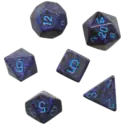Adventure (role-playing games)
An adventure is a playable scenario in a tabletop role-playing game. These can be constructed by gamemasters[lower-alpha 1] for their players, and are also released by game publishers as pre-made adventure modules. Different types of designs exist, including linear adventures, where players move between scenes in a pre-determined order; non-linear adventures, where scenes can go in multiple directions; and solo adventures, which are played alone, without a game group.
.jpg.webp)
| Part of a series on |
| Role-playing games |
|---|
 |
| Types |
| Topics |
| Terminology |
| Lists |
|
|
|
Overview
An adventure is a playable scenario in a tabletop role-playing game which a gamemaster[lower-alpha 1] leads the players and their characters through. Various types of designs exist, including linear adventures, where players need to progress through each pre-determined scene in turn; and non-linear adventures, where each situation can lead in multiple directions. The former is more restrictive, but is easier to manage, whereas the latter is more open-ended but more demanding for the gamemaster. A series of adventures played in succession are collectively called a campaign.[2] Adventures meant to be played alone, without a game group, are called solo adventures.[3]
Adventures can be created by gamemasters, but are also released by game publishers in the form of modular, supplementary books for role-playing games, sometimes combined with additional game mechanics or background information on the game's setting.[2][4] Pre-written adventure modules have the advantage of being easier to run for new gamemasters,[5] especially linear ones.[2] Still, it is most common for groups to play adventures they have made up themselves, and even when playing published adventures, it is common for alterations to be made.[6]
"Dungeon crawl"-style adventures for combat-intensive games such as Dungeons & Dragons may allow or require large amounts of combat and little or no interaction with other characters outside of combat; storytelling-focused such as the World of Darkness series may focus on character interaction and provide little opportunity for combat.
History
Published adventure modules began in 1975 with Dave Arneson's The Temple of the Frog, released for the Dungeons & Dragons setting Blackmoore,[7] and have since then become commonplace in the role-playing game industry; White Wolf Publishing, a major role-playing game publisher in the 1990s and 2000s, stood out by rarely publishing adventure modules, preferring to let gamemasters construct their own adventures.[4][8] Solo adventures rose in popularity in 2020, as a result of the COVID-19 pandemic preventing people from playing role-playing games together in person.[3]
See also
Notes
- The role of the person leading the game is variously called the "gamemaster", "storyteller", or "dungeon master" in different role-playing games.[1]
References
- Allison, Peter Ray (2020-02-06). "Shedding light on World of Darkness, the gothic-punk universe of RPG Vampire: The Masquerade". Dicebreaker. Gamer Network. Archived from the original on 2020-07-13. Retrieved 2020-09-04.
- "Glossaire" [Glossary]. Casus Belli Hors Série (in French). No. 25, Manuel Pratique du Jeu de Rôle. Excelsior Publications. May 1999. p. 6.
- "New Solo Adventure Released for Call of Cthulhu". Tabletop Gaming. Warners Group Publications. 2020. Archived from the original on 2020-11-24. Retrieved 2020-12-19.
- Baker, Eric T. (August 2000). "Games". Realms of Fantasy. No. 6. Sovereign Media. pp. 74–79.
- Heller, Emily (2019-02-21). "A beginner's guide to playing Dungeons and Dragons". Polygon. Vox Media. Archived from the original on 2020-12-15. Retrieved 2020-12-19.
- Beatie, Scott (2007-10-01). "Voicing the Shadow—Rule-playing and Roleplaying in Wraith: The Oblivion". Law, Culture and the Humanities. 3 (3): 477–492. doi:10.1177/1743872107081432.
- Appelcline, Shannon (2014). Designers & Dragons: The '70s (2nd ed.). Evil Hat Productions. pp. 19–20. ISBN 978-1-61317-075-5.
- Appelcline, Shannon (2014). Designers & Dragons: The '90s (2nd ed.). Evil Hat Productions. p. 19. ISBN 978-1-613170-84-7.